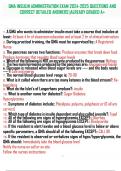Summary
Summary Principles of Corporate Finance COMPLETE Solution manual - edition 12 - CH16 - CH20 &27 (Brealey, Myers,)
- Module
- Institution
- Book
Corporate finance principles of principles of coporate finance brealey myers 12th edition 12 edition twelfth edition twelve economics corporate finance solution manual solution manual answers impacts minicase mini case Study guides, Class notes & Summaries Looking for the best study guides, study ...
[Show more]













